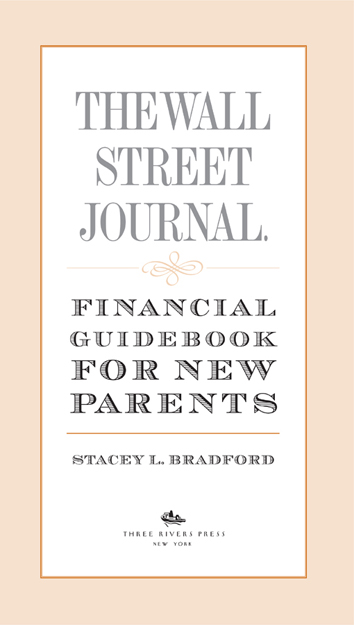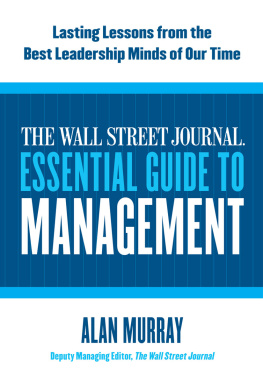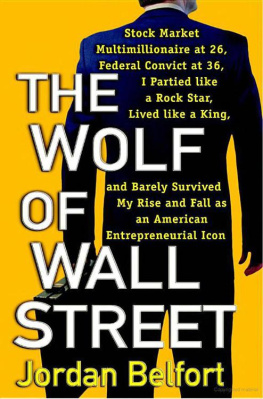Stacey L. Bradford - The Wall Street Journal. Financial Guidebook for New Parents
Here you can read online Stacey L. Bradford - The Wall Street Journal. Financial Guidebook for New Parents full text of the book (entire story) in english for free. Download pdf and epub, get meaning, cover and reviews about this ebook. genre: Home and family. Description of the work, (preface) as well as reviews are available. Best literature library LitArk.com created for fans of good reading and offers a wide selection of genres:
Romance novel
Science fiction
Adventure
Detective
Science
History
Home and family
Prose
Art
Politics
Computer
Non-fiction
Religion
Business
Children
Humor
Choose a favorite category and find really read worthwhile books. Enjoy immersion in the world of imagination, feel the emotions of the characters or learn something new for yourself, make an fascinating discovery.

- Book:The Wall Street Journal. Financial Guidebook for New Parents
- Author:
- Genre:
- Rating:4 / 5
- Favourites:Add to favourites
- Your mark:
- 80
- 1
- 2
- 3
- 4
- 5
The Wall Street Journal. Financial Guidebook for New Parents: summary, description and annotation
We offer to read an annotation, description, summary or preface (depends on what the author of the book "The Wall Street Journal. Financial Guidebook for New Parents" wrote himself). If you haven't found the necessary information about the book — write in the comments, we will try to find it.
The Wall Street Journal. Financial Guidebook for New Parents — read online for free the complete book (whole text) full work
Below is the text of the book, divided by pages. System saving the place of the last page read, allows you to conveniently read the book "The Wall Street Journal. Financial Guidebook for New Parents" online for free, without having to search again every time where you left off. Put a bookmark, and you can go to the page where you finished reading at any time.
Font size:
Interval:
Bookmark:


OTHER BOOKS FROM
THE WALL STREET JOURNAL
The Wall Street Journal. Guide to the Business of Life
Nancy Keates
The Wall Street Journal. Complete Money & Investing Guidebook
Dave Kansas
The Wall Street Journal. Complete Personal Finance Guidebook
Jeff Opdyke
The Wall Street Journal. Complete Personal Finance Workbook
Jeff Opdyke
The Wall Street Journal. Complete Real-Estate Investing Guidebook
David Crook
The Wall Street Journal. Complete Identity Theft Guidebook
Terri Cullen
The Wall Street Journal. Complete Retirement Guidebook
Glenn Ruffenach and Kelly Greene
The Wall Street Journal. Complete Home Owners Guidebook
David Crook
The Wall Street Journal. Guide to Starting Your Financial Life
Karen Blumenthal
T O R ICK AND L EYNA

I NTRODUCTION :
N OW THE F UN B EGINS
PART ONE
WHEN BABY MAKES THREE
CHAPTER 1
Y OUR M ATERNITY (OR P ATERNITY) LEAVE
CHAPTER 2
K ISSING T HAT C UBICLE G OOD-BYE
CHAPTER 3
R ETURNING TO THE G RIND
CHAPTER 4
W HO S AYS U NCLE S AM D OESNT C ARE ?
CHAPTER 5
W HERE S HOULD YOU N EST ?
PART TWO
NO ONE EVER SAID
KIDS WERE CHEAP
CHAPTER 6
F INDING (AND P AYING FOR) M ARY P OPPINS
CHAPTER 7
A VOIDING A H EALTH S CARE
CHAPTER 8
P AYING FOR H ARVARD
PART THREE
YOUR CONTINGENCY PLAN
CHAPTER 9
Y ES , Y OU N EED A W ILL
CHAPTER 10
T RUSTS : T HEY A RENT J UST FOR THE W EALTHY
CHAPTER 11
L IFE I NSURANCE : B ETTER S AFE T HAN S ORRY
CHAPTER 12
A CCIDENTS H APPEN ARE Y OU P REPARED ?

No one ever said having children was easy. First there are the 4:00 a.m. feedings, then the terrible twos, and before you know it, its time to start worrying about those dreaded teenage years. And on top of the stress of caring for a child, you have to figure out how to cover all the expenses for one.
Ready for sticker shock? The average family spends between $11,000 and $16,000 raising their child during his first year and more than $200,000 before that child turns eighteen, according to the U.S. Department of Agriculture. Indulge in pricey items, such as a $900 Bugaboo stroller and private schools, and expenses can easily skyrocket to over $1 million. Add a second child and you had better expect to spend twice as much. (Sorry, folks, few economies of scale to be found here.) If parents dont have a handle on everything from child tax credits and the Family and Medical Leave Act of 1993 to flexible spending accounts and 529 plans, they could end up squandering precious dollars that will leave them coming up short just when its time to pay for college.
Fortunately, there is a solution: planning. Trust me, I know it isnt easy to keep the big picture in mind when you have small children. Immediate expensessuch as outfitting a nurseryalways seem to trump efforts to fund longer-term goals. After my daughter was born, I, too, found the experience bewildering and intimidating, and I write about this stuff for a living. Its one thing to know I should open a college fund and another to find the time to set one up in between feedings.
Butand this is good news!the reality is that it didnt take nearly as much effort or time as Id feared to set up a long-term plan for my new family. My husband and I attacked the project in three steps. First, we put our estate in order, then we set a budget for our immediate needs; finally, we tackled the proverbial elephant in the roomthe college savings account. The challenge, of course, was how to balance all of this while continuing to fund our retirement.
We quickly realized that the only way to make our financial plan work was by keeping our baby-related spending to a minimum. Unfortunately, it proved much more difficult than we imagined not to get caught up in the race to keep up with the other moms and dads. While I was parking my perfectly adequate stroller at a playgroup one afternoon, one mom looked inquisitively at me and finally asked if I had left my Bugaboo at home. Im ashamed to admit it, but I actually found myself feeling embarrassed and could barely answer the question. Looking back, I wished I had said that I banked the extra $700 in my kids college savings fund.
Having a plan, however, doesnt mean you cant ever splurge on things that are important to you. For instance, we decided to spend $450 for a professional photographer to come to our home and capture our seven-month-olds toothless grin. Sure, we could have spent a fraction of that on prints from a retailers studio, but we wanted something more intimate and felt the cost was worth it. We had also budgeted for one extravagant item during our daughters first year, so we knew we could afford to make this choice. For you that one extravagant thing might be the Bugaboo, having a baby nurse or throwing a lavish first-birthday party. The point is that this book is designed to give you the flexibility to choose your own indulgences while maintaining your familys financial security.
So for all of you parents who want to provide a secure future for your children but simply dont know where to start, The Wall Street Journal. Financial Guidebook for New Parents provides your road map. In these chapters, youll receive a step-by-step plan for getting your familys finances in order that is relevant whether you are expecting, have an infant or have a handful of kids in elementary school or older.
ACTION PLAN FOR PARENTS
Dont have time to sit down and read this book from cover to cover? This ten-step game plan is a quick and handy reference to jump-start your familys finances.
Draft a will and name a guardian.
Draw up a trust and name a trustee.
Buy life insurance and consider a life insurance trust.
Track your spending and develop a family budget.
(Continue to) set aside money for retirement.
Take advantage of all tax-advantaged benefits at work (health care flexible spending account, dependent care account, etc.).
Take advantage of child-friendly tax credits and deductions.
Set up a college fund (only if you can afford it).
Set up a savings plans for other long-term goals, including a larger home.
Reassess your budget as your situation changes (additional kids, change in child care needs, etc.).

This book is broken down into three sections. Part One, When Baby Makes Three, helps readers make the financial transition from carefree individuals to parents.
Font size:
Interval:
Bookmark:
Similar books «The Wall Street Journal. Financial Guidebook for New Parents»
Look at similar books to The Wall Street Journal. Financial Guidebook for New Parents. We have selected literature similar in name and meaning in the hope of providing readers with more options to find new, interesting, not yet read works.
Discussion, reviews of the book The Wall Street Journal. Financial Guidebook for New Parents and just readers' own opinions. Leave your comments, write what you think about the work, its meaning or the main characters. Specify what exactly you liked and what you didn't like, and why you think so.




